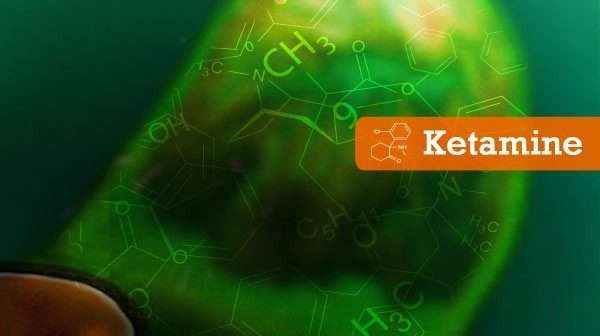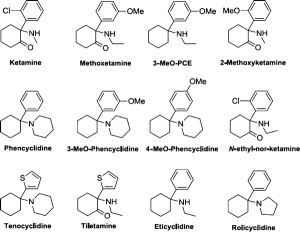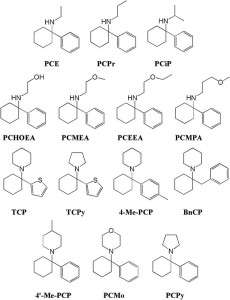
Dissociatives
Dissociative drugs belong to the class of anesthetics, which are also called “dissociative anesthetics”, since initially the purpose of their elimination was exclusively medical.
The meaning of the name of drugs “dissociatives” is that these drugs disrupt and unbalance the elements of the mind, break the connections between neuroreceptors. Memory, perception, consciousness and motor activity become dissociated from each other under the influence of this substance.
Dissociatives are practically not used in anesthesia, since they have a known unpredictable effect when exiting it. A similar effect can occur with other types of anesthesia, but it is with dissociatives that it is most often present.
Dissociative anesthesia is not applied to humans, but they are practiced by veterinarians using similar anesthetics on animals.
The most unusual psychedelic effect that dissociatives give is the ability of consciousness to separate from the physical body, access to parallel worlds, communication with unreal beings and even time travel.
Most of the people who took part in experiments related to dissociatives found the effects quite unpleasant, but the experience gained was recognized as valuable. Also during the experiments it became known that through the use of this drug, one can experience death while in a special state of consciousness. People who experienced the experience of death through dissociatives remembered this moment as the most difficult and painful in their lives. None of these people wanted to experience this feeling again.
Types of dissociative drugs: ketamine, phencyclidine (PCR), atropine, henbane, datura, mandrake, taran, dextromethorphan (DXM).
As you know, atropine is considered the most difficult drug of dissociatives, and it is also the most dangerous of all. A person under the influence of atropine usually has a feeling of loss of control over all functions, as well as a state akin to insanity.
The most common types of dissociative drugs that you need to know about

Ketamine
It is a psychotropic substance of synthetic origin. The chemical name of ketamine is 2-(methylamino)-2-(2-chlorophenyl)-cyclohexane hydrochloride.
Ketamine is included in group II of psychotropic substances in the official list of drugs. This substance has a limited turnover in the Russian Federation and is subject to the law of Article 226 of the Criminal Code “sale and other actions related to the purpose of sale”. In medical institutions, full control has been carried out in the use of this potent drug.
Ketamine is an oily liquid that is produced in 10 and 50 ml glass vials.
The main method of using ketamine is intravenous and intramuscular injection, as well as intronasal administration. How does this happen? The liquid composition is evaporated and dried, as a result of which the resulting powder is consumed by inhalation into the nose.
Ketamine use:
At any dosage, regardless of the amount of the drug administered, a person experiences very strong hallucinations. Among the side effects, the most common is an attack of nausea.
A person who has used this substance, even in small doses, is subject to speech and coordination disorders.
In case of overdose, loss of temporal-spatial orientation may occur, in rare cases – loss of consciousness.
The drug first appeared at the University of Michigan in 1962 and was used as an anesthetic, but in the United States it was practiced for a short time, due to strong psychotic reactions. It was even called the “philosopher’s stone” for its metaphysical properties, which doctors regarded as “acute reactions”, and eventually the drug was banned.
Ketamine was actively used in Vietnam as a means for anesthesia, which was recognized by Vietnamese scientists and doctors as a safe general anesthetic.
The Psychedelic side of Ketamine
Despite the fact that this drug causes psychotic reactions and has an extremely strong effect on consciousness, it does not cause feelings of bliss – euphoria, so it has not become popular among drug addicts. Those people who study various mental states, personality disorders and changes in consciousness are interested in ketamine and conduct various experiments.
Another curious fact is that ketamine does not cause dependence in 90%, with the small exception of those who took this drug very often and in large dosages.
Phencyclidine (PCR)
Phencyclidine was synthesized in 1956 in the USA, and in the early 60s it appeared in San Francisco clinics under the name PeaCePill (abbreviated name PCP).
This drug is better known as “angel dust”. In 1957, the first studies of phencyclidine in humans were conducted as an analgesic drug. It had an analgesic effect, but scientists and doctors were concerned about side effects, in the form of hallucinations, delirium and disorientation. Due to severe side effects, the use of the drug in humans was discontinued. In 1967, PCP began to be sold as an anesthetic for animals, used for strictly veterinary purposes.
In the 70s, phencyclidine was placed on the list of prohibited psychotropic substances, but until that time it was legal and was on free sale. During the 60s, after the ban on the drug LSD was established, drug addicts found a simple and inexpensive way to change the state of consciousness – PCP, it was at that time that the name “angel dust” was coined for it.
Phencyclidine causes hallucinations with all methods of use, but most often it is used when smoking.
The effect of consumption
If the dosage is weak, then it causes a feeling of lightness, good mood, decreased sensitivity. Signs of drug intoxication are similar to the state of alcoholic intoxication. Just as with alcohol intoxication, movement coordination disorders, changes in articulation of speech (speech becomes slurred), changes in states (a feeling of aggression, excitement and activity may appear, or, conversely, depression and inhibition may occur) are often noted. In a person who has taken a small dose of PCR, it is possible to note an increase in blood pressure, palpitations, increased sweating, visual impairment. Sometimes there is a so–called nystagmus – involuntary twitching of the eyeball.
As for visual impairment, the signs are again similar to alcohol intoxication – double vision, surrounding objects look fuzzy, floating, and so on.
When using phencyclidine, tactile hallucinations often occur, while visual visions are practically not observed. For example, objects seem excessively hot or excessively cold, all this is accompanied by feelings that someone is crawling on a person’s skin or even inside. According to the results of experiments, crawling insects are the most frequent hallucination.
Some people feel incredible physical strength under the influence of PCR and their pain sensitivity is completely lost. At the same time, under the influence of the drug, the desire for violence or suicide may appear.
Overdose
Unlike ketamine, PCP has a greater danger. An overdose of the drug can lead to an epileptic seizure, coma, or even death from suffocation. One of the most common diseases associated with long-term use of phencyclidine is neurotoxic brain damage, known as Olney damage.
It is also important that this narcotic substance is excreted from the body for a very long time, its components are contained in the urine for another month after initial use. Prolonged use of PCR can lead to addiction.
People who have experience of using psychotropic substances note that this is the most evil and unpleasant drug of all existing drugs. According to these people, over time, a person turns into a biorobot – he loses his will, personality, does not feel pain and is ready to obey.
Dextromethorphan (DXM)
This drug is used in medicine as an antitussive agent, and is also part of many cough remedies and syrups.
The chemical name is dextromethorphan hydrobromide. DXM is a synthetic substance similar to morphine.
The drug is widely used in the USA, as a substitute for codeine for colds and coughs. DXM, unlike codeine, does not contain opiates, so it is safer and does not cause physical addiction. While codeine was increasingly used as a narcotic.
DXM appeared in 1958 and in the same year was approved for sale as a cough remedy.
In the early 70s, the drug was withdrawn from sale due to numerous cases of use as a narcotic.
By the end of the 20th century, DXM was actively used as a psychotropic substance in narcotic circles.
The effect of DXM
The drug has several varieties of effect, called plateaus.
There are four plateaus in total:
Stimulating effect, slight increase in sensitivity, elated mood, mild excitement
Excitement, a state of intoxication
Dissociative state comparable to a low dose of ketamine
Absolute dissociation of the state, comparable to a large dose of ketamine
What is the danger hiding in
DXM is very life-threatening in large doses. Intoxication is accompanied by nausea, vomiting, diarrhea, high fever, dizziness. Against the background of an overdose, psychoses, breakdowns, depression can also occur. In the case of transition to the chronic stage, various mental illnesses may occur (in particular, paranoia), serotonin syndrome, stroke, which lead to a fatal outcome.
At the first use, the following side effects are possible: nausea, dizziness, stomach cramps, allergies, hypertension, sexual impotence, excessive sweating, insomnia, tachycardia, high fever.

